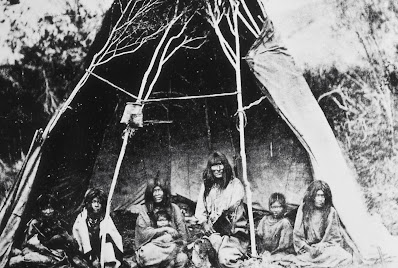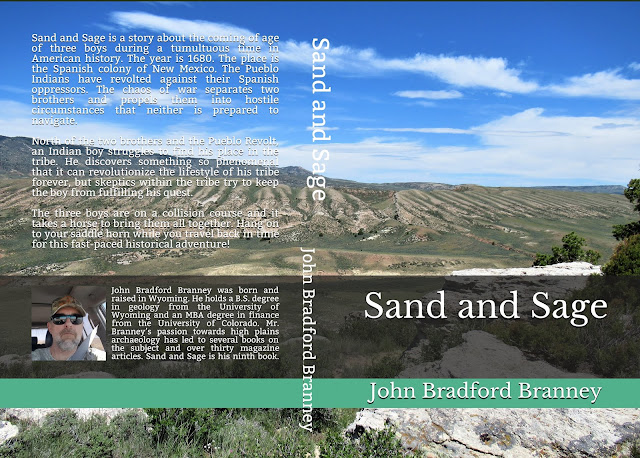My ninth book SAND and SAGE took place in the late 1600s in the southwest and high plains portions of the United States. By the early 1600s, Plains Indian tribes still did not have horses yet. It was not until the Spaniards arrived in the southwest part of the United States that horses became available to the Indians.
Imagine what it would be like to live an isolated existence like many Plains Indian tribes and to spot a horse for the very first time, or even more unbelievable, see a human riding A horse! Pretend it was you in that situation. How would you react? How would you explain it to other members of your tribe?
It wouldn't be easy, would it?
The blue passage below is from my historical fiction novel titled SAND and SAGE. In that part of the book, we meet a young Indian boy named Ouray, and his sweetheart named Haiwee. They belong to a tribe called the Snakes (a.k.a. Shoshone) and are out walking the hills surrounding their village. Ouray and Haiwee discover some very odd animal tracks that neither of them can explain. Those animal tracks started an avalanche of events that changed Ouray and Haiwee's lives forever.
Did you hear that?” an Indian boy named Ouray asked the girl alongside him.
“I heard it,” a tall girl named Haiwee replied.
“Meat, Haiwee!” Ouray bellowed much too loudly. “Follow me!”
Ouray nocked an arrow onto the bowstring of his old wooden bow. He crept forward, heading in the direction of the sound. Haiwee followed, giggling at Ouray’s seriousness.
“Quiet!” Ouray instructed the girl. Ouray bent over and studied the ground. When Ouray found the tracks, he smiled but the smile quickly darkened into a frown.
“What is wrong?” Haiwee asked.
Ouray did not answer. He had never seen such tracks. By the size of them, the beast was huge. Bent over, Ouray followed the tracks until they disappeared across bare rock.
“I have never seen tracks like these,” he muttered.
“That does not surprise me,” Haiwee replied. “You are a hunter of rabbits and grasshoppers.”
Ouray did not appreciate the critique on his hunting prowess. All boys wanted to be hunters of great beasts, not rabbits and grasshoppers. Oftentimes, Haiwee underestimated Ouray’s abilities. He peered over his shoulder and glared at her.
“What?” she demanded. “Is that not true?”
“Quiet,” he whispered.
“Remember the time yo—”
"Quiet!” Ouray exclaimed. “I cannot think with your constant yap-yap-yapping like an old mother coyote.”
“You are making more noise than me with your yap-yap-yapping,” Haiwee whispered.
Ouray knew he had already lost the argument with Haiwee. He always did.
“I need your help,” he said, changing the subject.
“Oh,” Haiwee responded with sarcasm, “the great hunter needs help from an old mother coyote.”
Ouray placed his hand alongside the horse hoofprint on the ground.
“Look at this,” he said.
Still in a huff, Haiwee bent her tall frame toward the ground. Her thick red hair fell forward, covering her face. She grabbed her hair and pulled it back into a ponytail. She held her hair with one hand while inspecting the track with her other hand. She traced the outline of the track with her finger.
“That is an elk,” she declared.
“Ha! Ha! Ha!” Ouray laughed aloud.
Haiwee glared at the boy, stopping Ouray’s chuckling dead in its tracks.
“It is not elk,” he replied politely.
“How do you know?” Haiwee questioned.
“What is wrong?” Haiwee asked.
Ouray did not answer. He had never seen such tracks. By the size of them, the beast was huge. Bent over, Ouray followed the tracks until they disappeared across bare rock.
“I have never seen tracks like these,” he muttered.
“That does not surprise me,” Haiwee replied. “You are a hunter of rabbits and grasshoppers.”
Ouray did not appreciate the critique on his hunting prowess. All boys wanted to be hunters of great beasts, not rabbits and grasshoppers. Oftentimes, Haiwee underestimated Ouray’s abilities. He peered over his shoulder and glared at her.
“What?” she demanded. “Is that not true?”
“Quiet,” he whispered.
“Remember the time yo—”
"Quiet!” Ouray exclaimed. “I cannot think with your constant yap-yap-yapping like an old mother coyote.”
“You are making more noise than me with your yap-yap-yapping,” Haiwee whispered.
Ouray knew he had already lost the argument with Haiwee. He always did.
“I need your help,” he said, changing the subject.
“Oh,” Haiwee responded with sarcasm, “the great hunter needs help from an old mother coyote.”
Ouray placed his hand alongside the horse hoofprint on the ground.
“Look at this,” he said.
Still in a huff, Haiwee bent her tall frame toward the ground. Her thick red hair fell forward, covering her face. She grabbed her hair and pulled it back into a ponytail. She held her hair with one hand while inspecting the track with her other hand. She traced the outline of the track with her finger.
“That is an elk,” she declared.
“Ha! Ha! Ha!” Ouray laughed aloud.
Haiwee glared at the boy, stopping Ouray’s chuckling dead in its tracks.
“It is not elk,” he replied politely.
“How do you know?” Haiwee questioned.
To find out the kind of animal that Ouray and Haiwee discovered, you will have to read SAND and SAGE.
I am sure you will enjoy the read!
 |
| Figure Two - Photograph of Shoshone Indians in 1871. Photo by William H. Jackson. When did the Snake or Shoshone People encounter horses? |
In their book, The Shoshones: Sentinels of the Rockies, Trenholm and Carley described a mid-eighteenth-century story about Shoshone warriors showing up for battle in the Blackfoot tribe's country. According to the testimony of Blackfoot warriors, the Shoshone warriors were riding strange animals as 'swift as deer'. During the course of the battle, the Blackfoot warriors isolated and killed a Shoshone warrior and the animal he was riding. The Blackfoot warriors were astonished at the horse's great size and at first, they called it a 'big dog', after the only domesticated animal they were familiar with. Later, the Blackfoot tribe referred to horses as 'stags that lost their horns' or 'elk dogs'.
In 2002, Peter Faris wrote an article in the Southwestern Lore journal about a Blackfoot warrior named Shaved Head who first saw horses in the early 1700s in the camp of an enemy. Shaved Head referred to those animals in his tongue as 'big dogs' or 'elk that have lost their horns'. Shaved Head and other Blackfoot warriors captured a few horses and took them to their village. At first, no one in the village knew what to do with the animals until one ingenious soul hooked up a dog travois to one of the horses and the rest became history.


